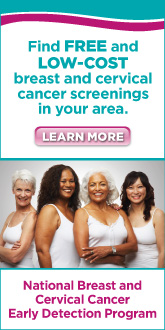Increasing Breast and Cervical Cancer Screening
Oklahoma Central Cancer Registry
In an effort to restructure the Oklahoma Breast and Cervical Cancer Early Detection Program (BCCEDP) service delivery system, the Oklahoma BCCEDP needed a different way to identify areas with the highest risk and the greatest need for services while ensuring that services were being provided to women in greatest need in the most cost-effective manner possible.
The following variables were used to identify counties of highest need, weighted by importance in the following order: women in need estimates, proportion of late-stage breast cancer diagnoses, mammography screening, breast cancer mortality, Pap tests, and cervical cancer mortality. Each variable was ranked by county and weighted by importance. The resulting totals were split into five quintiles and assigned a grade. The counties with the worst grades are considered at highest need.
These variables were incorporated into the model due to several known disparities. Deaths from breast and cervical cancer occur disproportionately among women who are uninsured or underinsured. Screening tests are underused by women who have little or no regular source of health care, women without health insurance, and those who have immigrated to the United States in the past 10 years.
The study found that of the 15 counties with the highest need, none had a screening rate above 66%. Three of these Grade F counties offer no screening services. Two of the highest need counties also had the lowest grade for proportion of women screened; no screening services are offered in either of these counties. The five main groups of counties with the highest need are located in the eastern part of the state.
The current service delivery system has 42 counties with no screening services: 13 (31%) Grade A, nine (21%) Grade B, 10 (24%) Grade C, seven (17%) Grade D, and three (7%) Grade F. With the proposed changes, 19 counties would offer no screening services: 10 (53%) Grade A, five (26%) Grade B, two (11%) Grade C, and two (11%) Grade D.
Incorporating incidence, mortality, and screening data from multiple surveillance systems into one consolidated data system can be a powerful tool in program planning. Presenting this information on a map is easy to understand and delivers the desired message quickly even when using complex data.
Contact Us:
- Centers for Disease Control and Prevention
Division of Cancer Prevention and Control
4770 Buford Hwy NE
MS K-64
Atlanta, GA 30341 - 800-CDC-INFO
(800-232-4636)
TTY: (888) 232-6348
8am–8pm ET
Monday–Friday
Closed on Holidays - cdcinfo@cdc.gov



